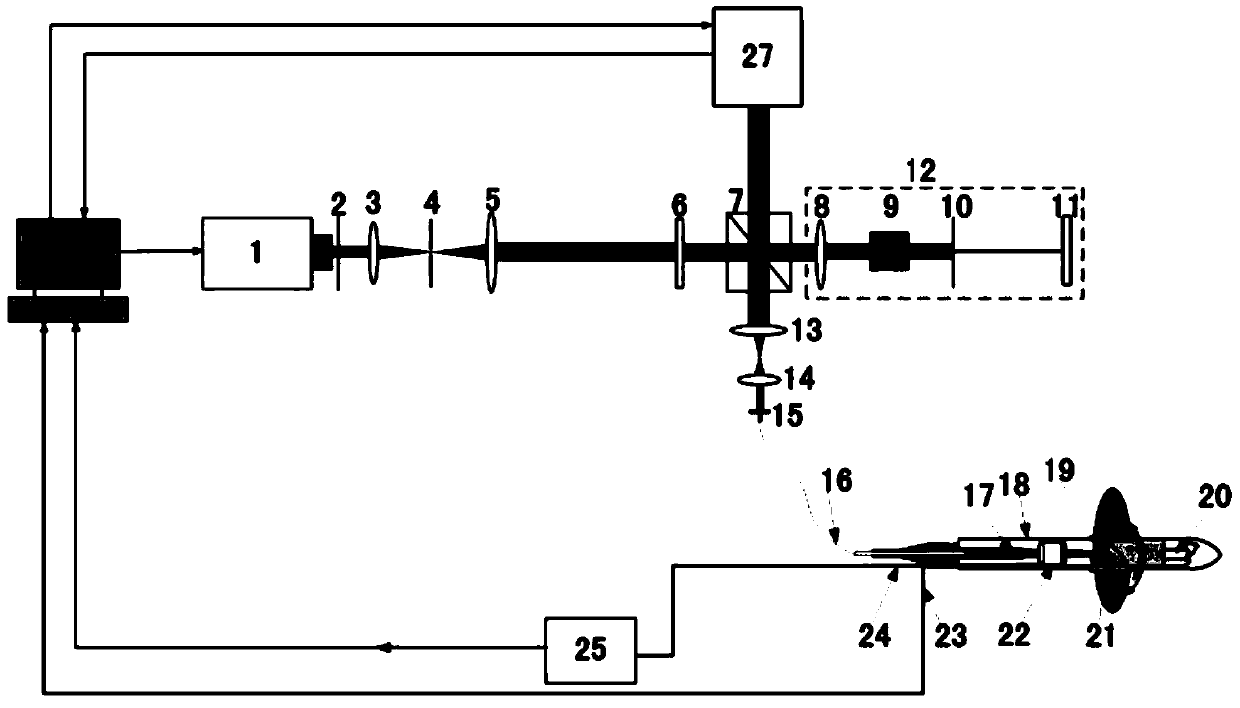Multimodal microscopic imaging system
A microscopic imaging, multi-modal technology, applied in medical science, sensor, endoscope, etc., can solve the problems of difficult coaxial, limited scanning speed, limited matching accuracy of scanning area, etc., to achieve simplified system structure, The effect of increased stability
- Summary
- Abstract
- Description
- Claims
- Application Information
AI Technical Summary
Problems solved by technology
Method used
Image
Examples
Embodiment 1
[0023] Such as figure 1 , figure 2 and image 3 As shown, this embodiment includes: laser light source 1, variable diaphragm 2, first lens group 3, 5, pinhole diaphragm 4, optical filter 6, beam splitter 7, reference arm 12, second lens group 13 , 14, collimating coupler 15, single-mode optical fiber 16, focusing lens 17, stainless steel sleeve 18, scanning mirror 19, driving motor 20, scanning window 21, ultrasonic transducer 22, motor cable 23, connecting wire 24, amplifier 25, control computer 26, photoelectric detector 27.
[0024] The reference arm 12 includes a focusing lens 8 , a dispersion compensation block 9 , a tunable diaphragm 10 and a mirror 11 .
[0025] The focusing lens 17 has the characteristic of gradually decreasing gradient refractive index distribution, which enables the light beam to transmit along the central axis of the endoscopic probe to produce continuous refraction, so that the incident beam converges smoothly and continuously, and focuses on o...
Embodiment 2
[0031] Such as figure 1 , figure 2 and image 3 As shown, this embodiment includes: an optical coherence tomography subsystem, a photoacoustic microscopic imaging subsystem, and an ultrasonic imaging subsystem combined with a multi-modal endoscopic imaging system composed of an endoscopic probe, and its main implementation steps as follows:
[0032] The first step: the laser light source 1 generates laser light and adjusts the spot size through the variable aperture 2, then passes through the first lens group 3, 5 and the pinhole aperture 4, the beam is collimated and expanded, and then enters the optical filter 6 for filtering. The light then passes through the beam splitter 7, a part of the laser light passes through the focusing objective lens 8, passes through the dispersing block 9, and passes through the adjustable aperture slit 10 to the mirror 11. This part serves as the reference arm 12 for optical coherence tomography, and the other part passes through the second ...
PUM
| Property | Measurement | Unit |
|---|---|---|
| Diameter | aaaaa | aaaaa |
| Diameter | aaaaa | aaaaa |
| Length | aaaaa | aaaaa |
Abstract
Description
Claims
Application Information
 Login to View More
Login to View More - R&D
- Intellectual Property
- Life Sciences
- Materials
- Tech Scout
- Unparalleled Data Quality
- Higher Quality Content
- 60% Fewer Hallucinations
Browse by: Latest US Patents, China's latest patents, Technical Efficacy Thesaurus, Application Domain, Technology Topic, Popular Technical Reports.
© 2025 PatSnap. All rights reserved.Legal|Privacy policy|Modern Slavery Act Transparency Statement|Sitemap|About US| Contact US: help@patsnap.com



